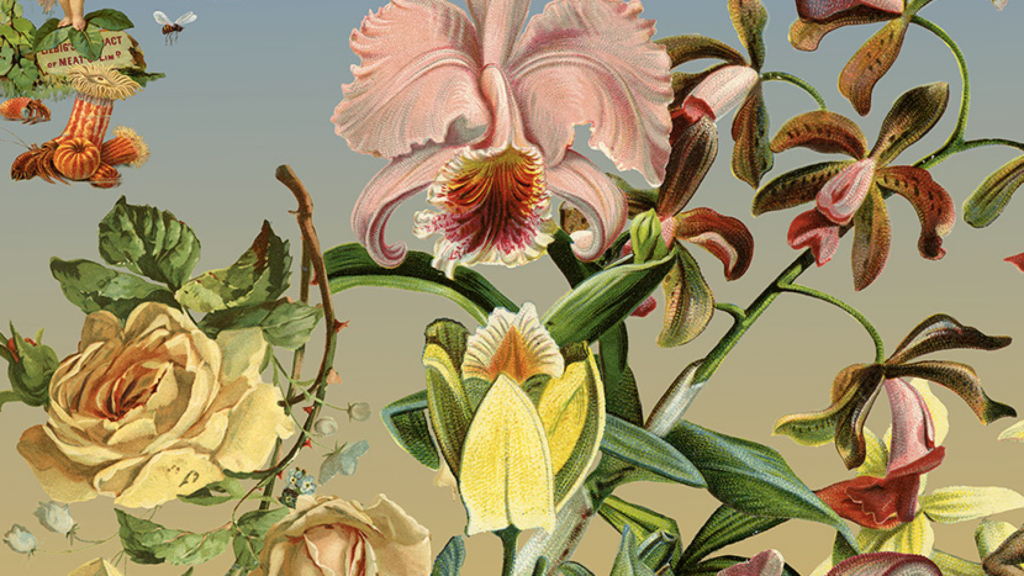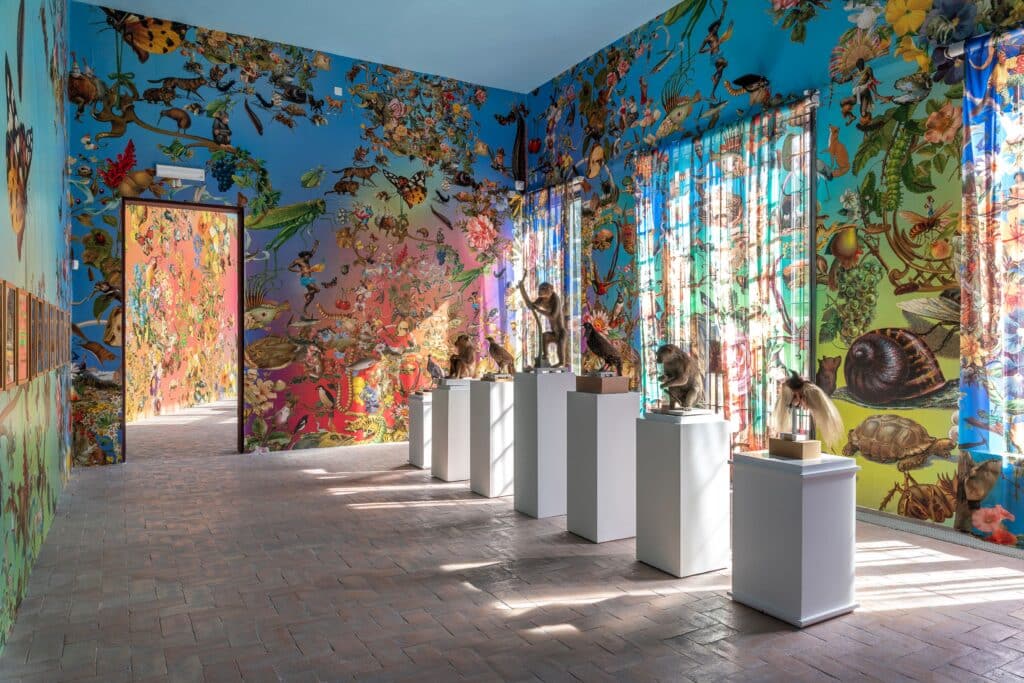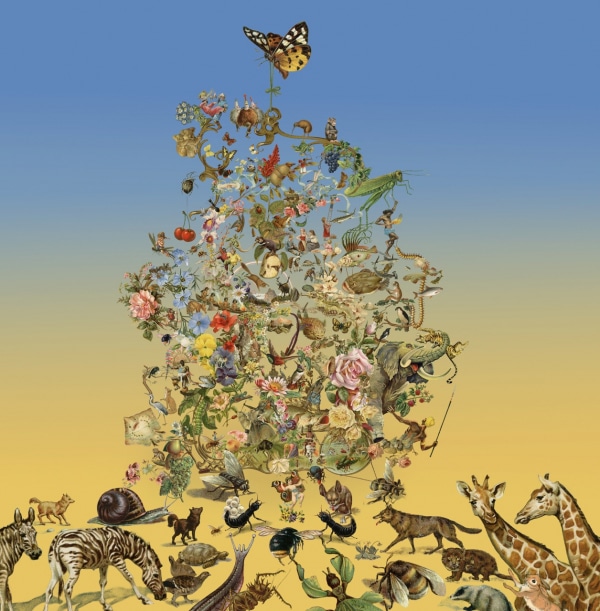Paradise Lost
The new site specific artwork “Paradise Lost” by artists David Allen Burns and Austin Young / Fallen Fruit, is currently on view in Modena, Italy, until August 24, 2025. The exhibition continues across two venues: the Palazzina dei Giardini Ducali and the Museo della Figurina .
EXHIBITION VENUE
La mostra di David Allen Burns e Austin Young / Fallen Fruit fino al 24 agosto alla Palazzina dei Giardini ducali e al Museo della Figurina

The 17th-century Palazzina dei Giardini Ducali hosts a lush paradise of flowers, plants, butterflies, birds, and animals of every type and species, created for the occasion to prompt reflection on the natural environment threatened by climate change. With the exhibition “Paradise Lost,” artists David Allen Burns and Austin Young / Fallen Fruit , drawing inspiration from historical image collections preserved at the Museo della Figurina, create an immersive environment that fills drapery and walls, reconstructing a kind of “lost paradise.”
Their work, beginning with their public fruit tree maps created in Los Angeles in 2004, has always maintained a strong connection to urban spaces and the idea of “sharing the world with others.”
Just a few steps from the Botanical Garden, a site-specific installation by the Californian duo is on view. In an environment rich with images and evocative elements, there are also specimens of taxidermy animals on display, on loan from the Museum of Zoology and Comparative Anatomy, part of the Unimore Museum and Botanical Garden system. Wolves, foxes, monkeys, birds, iguanas, and toads — silent witnesses immersed in the artwork — seem to come back to life, reminding us of the fragility of existence and the balance of nature.
The exhibition also extends to the Museo della Figurina, housed in Palazzo Santa Margherita, where visitors can admire the original images that inspired the artists. These are refined drawings accompanied by short texts written in the simple, educational style of popular encyclopedias, typical of vintage sticker albums — from “The Symbols of Flowers”to “Alpine Peaks,” “The Strength of Insects” to “Major Crops,” and on to “Butterflies and Cherubs” and “Children and Shells.”
Exhibition Details:
-
Dates: April 11 – August 24, 2025
-
Venues:
-
Palazzina dei Giardini Ducali, Corso Cavour 2, Modena
-
Museo della Figurina, Corso Canalgrande 103, Modena
-
-
Opening Hours:
-
April – June: Wednesday to Friday: 11:00–13:00 / 16:00–19:00; Saturday, Sunday, and holidays: 11:00–19:00
-
July – August: Wednesday to Sunday and holidays: 15:00–19:00
-
-
Admission:
-
Combined ticket for both venues: €10 (full price), €7 (Modena residents), €5 (concessions)
-
Free entry on the first Sunday of each month and every Wednesday for Modena residents
-
-
Guided Tours: Every Saturday at 17:00 (reservation required, no additional cost)
For more information and reservations, please visit the Fondazione AGO Modena Fabbriche Culturali website.

La seicentesca Palazzina dei Giardini ducali accoglie un lussureggiante paradiso di fiori, piante, farfalle, uccelli e animali di ogni tipo e specie creato per l’occasione dai Austin Young e David Allen Burns / Fallen Fruit, per suggerire una riflessione sull’ambiente naturale minacciato dai cambiamenti climatici. Con la mostra Paradise Lost, a cura di Francesca Fontana, gli artisti David Allen Burns e Austin Young, ispirandosi alle immagini di collezioni storiche conservate al Museo della Figurina, creano un ambiente immersivo che pervade tendaggi e pareti ricostruendo, appunto, una sorta di “paradiso perduto”. Le loro opere, a partire dalle mappe degli alberi da frutto pubblici realizzate a Los Angeles nel 2004, hanno sempre una stretta connessione con gli spazi urbani e con la propensione a “condividere il mondo con gli altri”.
A pochi passi dall’Orto botanico è esposta l’opera site–specific del duo californiano dove, in un ambiente carico di immagini e suggestioni, sono presenti anche esemplari di animali tassidermizzati, provenienti dal Museo di zoologia e anatomia comparata che fa parte del Sistema dei Musei e Orto Botanico di Unimore. Lupi, volpi, scimmie, volatili, iguane e rospi che, come testimoni silenziosi immersi nell’opera artistica, sembrano riacquistare nuova vita ricordandoci la fragilità dell’esistenza e dell’equilibrio della natura. La mostra si sviluppa anche nella sede del Museo della Figurina, a Palazzo Santa Margherita, dove si possono ammirare le immagini originali, quelle che hanno ispirato gli artisti. Disegni raffinati, accompagnati da testi illustrativi nello stile semplice, da piccola enciclopedia popolare, che caratterizzava gli album di figurine dell’epoca: dai “Simboli dei fiori” alle “Cime alpine”, dalla “Forza degli insetti” alle “Grandi coltivazioni”, fino a “Farfalle e amorini” o “Bambini e conchiglie”.
Per approfondimenti, consulta il comunicato stampa.

